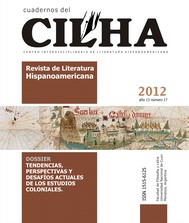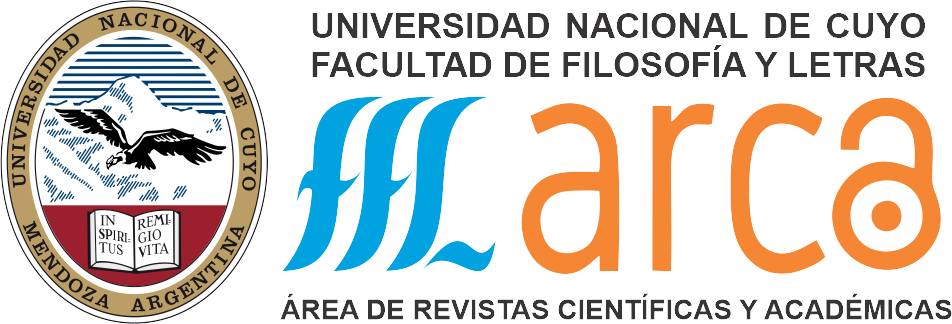Creole Painters, Casta Painting, and Internal Colonialism:
Racial Discourses in New Spain in the Late Viceregal Period
Keywords:
Casta painting, Creole agencies, Race, Mulatto, MestizoAbstract
The aim of the present article is to analyze casta paintings from the end of the eighteenth century from the perspective of creole agencies in New Spain. José Antonio Mazzotti´s concept of creole agencies is used here to propose an analysis on three interelated levels, that is, the impact of the Bourbon Reforms on the creole sector, the founding of the first creole art academies in New Spain, and the development and deployment of a creole racial discouse as well as the construction of racial stereotypes in casta painting. The general objective of the analysis is to become a point of inflection for weighing the relevance of racial discourse in the internal colonial space and in the cultural imaginaries formed during the decades that immediately preceeded the creole independence movements.
References
Bauer, Ralph y José Antonio Mazzotti (eds.). Creole Subjects in the Colonial Americas. Empires, Texts, Identities. North Carolina: The U of North Carolina P, 2009.
Bennett, Herman L. Colonial Blackness: A History of Afro-Mexico. Bloomington: Indiana UP, 2009.
Bertrand, Michel. "Las redes de sociabilidad en la Nueva España: fundamentos de un modelo familiar en México (siglos XVII-XVIII)". En: Charlotte Arnauld, et al (ed.). Poder y desviaciones: genesis de una sociedad mestiza en Mesoamérica. México: Siglo XXI, 1998: 103-33.
Bhabha, Homi. El lugar de la cultura. Trad. César Aira. Buenos Aires: Manantial, 2002.
Cañizares Esquerra, Jorge. "New World, New Stars: Patriotic Astrology and the Invention of Indian and Creole Bodies in Colonial Spanish America, 1600-1650", American Historial Review, n. 104, 1 (1999): 33-68.
Carrera, Magali Marie. Imagining Identity in New Spain. Race, Lineage, and the Colonial Body in Portraiture and Casta Painting. Austin: U of Texas P, 2003.
Carrera, Magali Marie. "Locating Race in Late Colonial Mexico", Art Journal, n. 57, 3, 1998: 36-45.
Chance, John K. y Taylor, William B. "Estate and Class in Colonial Oaxaca: Oaxaca in 1792", Comparative Studies in Society and History, n. 19, 3, 1977: 454-87.
Cori, Gabriel H. "Poder y administración en América colonial. Siglos XVII y XVXIII". En: Nidia Areces (ed.). La América española: Temas y fuentes.
Couto, José Bernardo. [1872]. Diálogo sobre la Historia de la Pintura en México. México, Imprenta de L. Escalante y CIA. En línea: Cervantes Virtual http://www.cervantesvirtual.com/obra-visor/dialogo-sobre-la-historia-de-la-pintura-en-mexico--0/html/dcb3663f-669f-4cf2-b650-345475d9bfea_8.html#I_2_ Citado: 14/02/12.
Covarrubias y Orozco, Sebastián. Tesoro de la lengua castellana o española. Madrid: Luis Sanchez, 1611.
Cummins, Thomas. "Casta Painting: Images of Race in Eighteenth-Century Mexico. (Imagining Identity in New Spain: Race, Lineage, and the Colonial Body in Portraiture and Casta Paintings)", Review of Casta Painting: Images of Race in Eighteenth-Century Mexico, por Ilona Katzew y Imagining Identity in New Spain: Race, Lineage, and the Colonial Body in Portraiture and Casta Paintings por Magali Carrera. Art Bulletin Publication, March 1 2006. En Web: http://www.accessmylibrary.com/coms2/summary_0286-15165117_ITM Citado: 20/02/12.
Deans Smith, Susan. "Creating the Colonial Subject: Casta Paintings, Collectors, and Critics in Eighteenth-Century mexico and Spain", Colonial Latin American Review, n. 14, 2, 2005: 169-204.
Donohue-Wallace, Kelly. "El grabado en la Real Academia de San Carlos de Nueva España 1783-1810". España: Biblioteca Virtual Española, 2004. En línea: http://www.americanismo.es/texto-completo-Donahue_Wallace_Kelly-El_grabado_en_la_Real_Academia_de_San_Carlos_de_Nu-2977.html Citado: 18/02/12.
Estrada de Gerlero, Elena Isabel. "Las pinturas de castas, imágenes de una sociedad variopinta". En: México en el mundo de las colecciones de arte: Nueva España. 2 vols. II. Ciudad de México: Grupo Azabache, 1994.
García Sáiz, María Concepción. Las castas mexicanas: Un género pictórico americano. Milan: Olivetti, 1989.
Gemelli Careri, Giovanni. Viaje a la Nueva España. Méxido DF: Dirección General de Publicaciones, UNAM, 1976.
González Casanova, Pablo. "Colonialismo interno (una redefinición)". Atilio Borón, Javier Amadeo y Sabrina Gonález (comps). La teoría marxista hoy. Problemas y perspectivas. Buenos Aires: CLACSO, Consejo Latinoamericano de Ciencias Sociales, 2006: 309-434. En línea: http://biblioteca.clacso.edu.ar/ar/libros/campus/marxis/P4C2Casanova.pdf Citado: 5/02/12.
Higgins, Antony. "Colonia e imperio: algunas reflexiones sobre la trayectoria de los estudios sobre la cultura y la literatura virreinales", Revista de Estudios Hispánicos, n. 35, 2001: 601-614.
Higgins, Antony. Constructing the Criollo Archive. Indiana: Purdue UP, 2000.
Katzew, Ilona. Casta Painting: Images of Race in Eighteenth-Century Mexico. New Haven: Yale UP, 2004.
Kellogg, Susan. "Depicting Mestizaje: Gendered Images of Ethnorace in Colonial Mexican Texts", Journal of Women’s History, n. 12, 3, 2000: 69-92.
Klor de Alva, Jorge. "The Postcolonization of the (Latin) American Experience: A Reconsideration of ´Colonialism,‘ ´Postcolonialism´ and ´Mestizaje‘". In: Gyan Prakash (ed.). After Colonialism: Imperial Histories and Postcolonial Displacements. Princeton: Princeton UP, 1995: 241-275.
Kuznesof, Elizabeth Anne. "Ethnic and Gender Influences on Spanish Creole Society in Colonial Spanish America", Colonial Latin American Review, n. 4, 1, 1995: 153- 176.
Lafaye, Jacques. "La sociedad de castas en la Nueva España". En: La pintura de castas. Artes de México, n. 8, 1998: 25-34.
Martínez, María Elena. Genealogical Fictions: Limpieza de Sangre, Religion, and Gender in Colonial Mexico. Stanford, CA: Stanford UP, 2008.
Martínez-San Miguel, Yolanda. Saberes americanos: Subalternidad y epistemología en los escritos de Sor Juana. Pittsburgh: Nuevo Siglo, 1999.
Mazzotti, José Antonio. Agencias criollas. La ambigüedad "colonial" en las letras hispanoamericanas. Pittsburgh: IILI, 2000.
Mazzotti, José Antonio. "Creole Agencies and the (Post)Colonial Debate in Spanish America". In: Moraña, et al (eds.). Coloniality at Large. Latin America and the Postcolonial Debate. Durham, NC: Duke University Press, 2008.
Mignolo, Walter. "La colonialidad a lo largo y a lo ancho: el hemisferio occidental en el horizonte colonial de la modernidad". En: Edgardo Lander (comp.). La colonialidad del saber: eurocentrismo y ciencias sociales. Perspectivas Latinoamericanas. Buenos Aires: CLACSO, Consejo Latinoamericano de Ciencias Sociales, 2000: 246. En línea: http://bibliotecavirtual.clacso.org.ar/ar/libros/lander/mignolo.rtf Citado: 10/02/12.
Mignolo, Walter. "La semiosis colonial: la dialéctica entre representaciones fracturadas y hermenéuticas pluritópicas", Adversus Revista de Semiótica, n. 3, 2005. En línea: http://www.adversus.org/indice/nro3/articulos/articulomignolo.htm Citado: 17/02/12.
Moyssén, Xavier. "La primera academia de pintura en México", Anales del Instituto de Investigaciones Estéticas, n. 34, 1965: 23-84.
Moyssén, Xavier. "Testamento de José de Ibarra", Boletín de monumentos históricos, Ciudad de México, n. 6, 1981: 41-52.
Mues Orts, Paula. La libertad del pincel. Discursos sobre la nobleza de la pintura en Nueva España. México DF: Universidad Iberoamericana, 2008.
Omi, Michael y Winant, Howard. Racial Formation in the United States: From the 1960s to the 1990s. New York: Routledge, 1994.
Parker Brienen, Rebecca. Visions of Savage Paradise: Albert Eckhout, Court Painter in Colonial Dutch Brazil. Amsterdam: Amsterdam UP, 2006.
Poot Herrera, Sara. "Los criollos: nota sobre su identidad y cultura", Colonial Latin American Review, n. 4 , 1, 1995: 177-183.
Quijano, Aníbal. "Colonialidad del poder, eurocentrismo y América latina". En: Edgardo Lander (comp.). La colonialidad del saber: eurocentrismo y ciencias sociales. Perspectivas latinoamericanas. Buenos Aires: CLACSO, 1993. En línea: http://bibliotecavirtual.clacso.org.ar/ar/libros/lander/lander.html Citado: 03/02/12.
Rama, Ángel. La ciudad letrada. Hanover: Ediciones del Norte, 1984.
Ramírez Montes, Mina. "En defense de la pintura. Ciudad de México, 1753", Anales del Instituto de Investigaciones Estéticas, n. 78, 2001: 103-128.
Saldaña, María Josefina. "Who´s the Indian in Aztlan? Rewriting Mestizaje, Indianism, and Chicanismo from the Lacadón". In: Ileana Rodríguez (ed.). Latin American Subaltern Studies Reader. Durham NC: Duke UP, 2001.
Seed, Patricia. "Social Dimensions of Race: México City, 1753", The Hispanic American Historical Review, n. 62, 4, 1982: 569-606.
Schwartz, Stewart B. "Colonial Identities and the Sociedad de Castas", Colonial Latin American Review, n. 4, 1, 1995: 185-201.
Soto, Myrna. El arte maestra. Un tratado de pintura novohispano. México DF: Instituto de Investigaciones Bibliográficas, 2005.
Stolcke, Verena. Racismo y sexualidad en la Cuba colonial. Madrid: Alianza, 1992.
Vega, Inca Garcilaso de la. Angel Rosenblat (ed.). Comentarios reales de los Incas. Comentarios reales de los Incas. Buenos Aires: Emecé, 1943.
Verdesio, Gustavo. "Todo lo que es sólido se disuelve en la academia: sobre los estudios coloniales, la teoría poscolonial, los estudios subalternos y la cultura material", Revista de Estudios Hispánicos, 35, 2001: 633-658.





















